
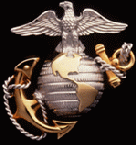
The Magnificent Flying Circus
in Vietnam, 1964-65
Squadron Weapons and Equipment
To help your search, type in key word
then look below for highlighted word
HMM-365 personnel, especially the pilots, flight crewmembers and the Combat Recovery Team personnel, were given a wide latitude on the individual weapons that they chose to carry to perform specific tasks. The squadron armory held a variety of weapons, not always regulation USMC Table of Organization weapons, but some which were inherited from the previous Marine helicopter squadrons assigned to Operation Shufly, and some which were acquired by other means - in Marine parlance, "comshaw".
Caliber .45, Submachinegun, M1A1
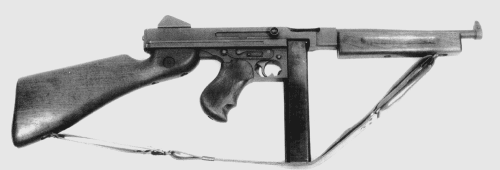
|
Caliber
|
.45 ACP (Automatic Colt Pistol)
|
|
Operation
|
Blowback, selective fire
|
|
Weight
|
10.45 pounds
|
|
Length
|
31.8 inches
|
|
Barrel
|
10.5 inches
|
|
Cyclic Rate
|
600-725 rounds/minute
|
|
Magazine
|
20- and 30-round boxes
50-round drum
|
|
This submachine gun was not an authorized weapon with the squadron Table of Equipment (ToE), this "Tommygun" was nevertheless coveted and carried by some squadron personnel. Squadron loadmaster Staff Sergeant Warren F. Atwood for one, carried his submachinegun minus its shoulder stock. In the early days of the Vietnam War this weapon could be obtained from the ARVN, who seemed to possess 90% of all the "tommy guns" ever produced, for a couple of cases of C-rations and 4 or 5 cartons of Salem cigarettes.
|
Nicknamed the "grease gun" for its resemblance to an auto mechanic's lubrication gun, this weapon was Lance Corporal Enrique del Rosario's weapon of choice when on missions with the squadron Combat Recovery Team. It seemed more portable than the issue M-14 rifle, especially if the team were called upon to rappell from a helicopter down to an unprepared debarkation site.
|
Caliber .45, Submachinegun, M3A1
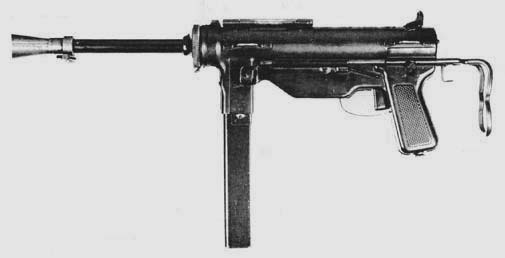
|
Caliber
|
.45 ACP
|
|
Operation
|
Blowback, automatic
|
|
Weight
|
8.15 pounds
|
|
Length
|
29.8 inches, stock extended
22.8 inches, stock retracted
|
|
Magazine
|
30-round box
|
|
Cyclic Rate
|
350-400 rounds/minute
|
|
Carl Gustav Submachinegun Model 45, 9mm parabellum
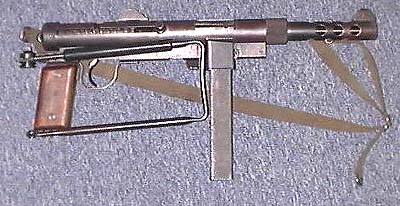
|
Caliber
|
9mm Parabellum
|
|
Operation
|
Elementary blowback. Actuation of bolt mechanism is by projection of spent case.
|
|
Weight
|
9.25 pounds
|
|
Length
|
31.8 inches, stock extended
21.7 inches, stock folded
|
|
Barrel
|
8 inches
|
|
Cyclic Rate
|
550-600 rounds/minute
|
|
Magazine
|
36-round box
|
|
This submachinegun was manufactured in Sweden and known by the pilots, crewmembers and CRT members who carried this weapon as the Swedish K. Originally brought into Vietnam by Central Intelligence Agency contractors, the Swedish Ks that made it into our squadron's armory inventory were acquired through trading.
|
M-16 Rifle, 5.56 mm

|
Caliber
|
5.56 mm NATO (.223 Remington)
|
|
Ammunition
|
Ball, general purpose
Armor-piercing
Tracer
|
|
Operation
|
Gas, selective fire
|
|
Weight
|
6.3 pounds
|
|
Length
|
39 inches
|
|
Magazine
|
20-round box
|
|
Cyclic Rate
|
700-900 rounds/minute
|
|
This rifle (really should be classified a carbine) was not a Marine Corps issue weapon at the time of HMM-365 Vietnam tours of duty. The M-16/AR-15 that the squadron got their hot little hands on probably came from the U.S. Air Force who, at that time, had more of these rifles than any other service in Vietnam; or from the U.S. Army 5th Special Forces Group, with whom we had very good working relations (and probably trade relations, too).
If I remember correctly, it was Lance Corporal Frank Bermudez who first demonstrated to us the effectiveness of this little black rifle by picking off two VC from his helicopter. The first shot hit one of the VC in the back of the neck and sent him tumbling head over heels, and the next shot hit the other Cong in the torso and literally severed his body in half. The AR-15s that we had came with 20-round magazines. Later magazines were to hold 30 rounds, but we didn't see any of these. This particular early issue model had a 1 in 14 inches lands and grooves twist in the barrel, imparting a spin on the the bullet that barely stabilized it, causing the bullet to "tumble" upon impact. This tumbling effect caused violent impact on soft targets, as what happened to two of Frank Bermudez's kills.
|
|
Already mentioned under Aerial Weaponry, the M-60 machinegun was also used by the squadron as a ground weapon. On each one of the Combat Recovery Team missions, at least one M-60 was carried. Everyone on the CRT knew how to fire and maintain the machinegun and anyone could at any time be designated the team machinegunner. The CRT would usually carry 1000 rounds or more of linked ammunition in steel boxes. No one in HMM-365 ever wore the linked ammo draped over their shoulders or wrapped around their waist as other units had allowed their machinegunners to do. Ammunition carried in this manner would unnecessarily expose it to dirt and other foreign matter, increasing the risk of a malfunction.
|
M-60 Machinegun
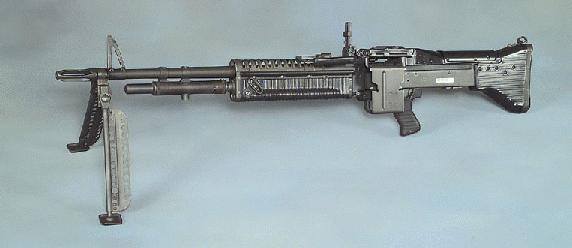
|
Caliber
|
7.62x51 mm NATO (.308 Winchester)
|
|
Operation
|
Gas, automatic
|
|
Weight
|
23.05 pounds
|
|
Length
|
43.75 inches
|
|
Feed device
|
Distintegrating link belt
|
|
Cyclic Rate
|
600 rounds/minute
|
|
The M-79 is a single-shot, break-open, shotgun-type shoulder weapon that was not part of the squadron's authorized Table of Equipment. It fires a 40mm grenade projectile of high explosives, canister pellets, or smoke.
Although it possesses only a crude folding leaf sight that is adjustable for windage and elevation, it can be used quite effectively by talented "thump-gunners", as was evident when in the hands of Sgt. Robert L. Frye against hostile forces attempting to interfere with HMM-365's landing zone operations. Frye, sitting in his customary crewchief position at the hatch of his UH-34D, spotted a VC 75 yards from the helicopter. Firing from the hip, he launched an HE grenade and hit that VC soldier square on the chest.
The facts to that point is indisputable. What happened to the VC after the 40mm grenade hit him, I have two conflicting reports. One is that the Cong was blown to smithereens. The other is that the round failed to detonate, and then one of our flight surgeons had to remove it surgically. After the round was removed, and while there was still a gaping hole in his chest, Charlie asked for and received a cigarette. He took one puff, and died of cancer.
|
M-79 Grenade Launcher

|
Caliber
|
40 x 46 mm SR
|
|
Grenades
|
High explosive, anti-personnel
Shot canister, anti-personnel
Smoke
|
Operation
|
Single shot, break-open type
|
|
Weight
|
6.45 pounds
|
|
Length
|
28.78 inches
|
|
Barrel
|
14 inches
|
|
Shotgun, Winchester Model 12 Trench Gun

|
Caliber
|
12 gauge, 2 3/4-inch
|
Operation
|
Slide-operation feed, semi-automatic fire
|
|
Weight
|
7.5 pounds
|
|
Length
|
39 inches
|
|
Barrel
|
20 inches
|
|
Shotguns were used mainly for interior guard duty, especially when patrolling in and around aircraft and other equipment and structures where projectile penetration may cause excessive collateral damage. This slide action repeating shotgun is equipped with a heat shield and bayonet lug. This 12-gauge weapon held five shells in its tubular magazine. The ammunition issued were 00-buck in brass casings. It can be "fan-fired", meaning that the shooter can cause the weapon to discharge its ammunition with a single pull of the trigger, as long as the trigger is kept in its rearward position and the slide is worked back and forward to chamber, fire, and eject each successive shell.
|
U.S. Carbine, Caliber .30, M1, M1A1, and M2
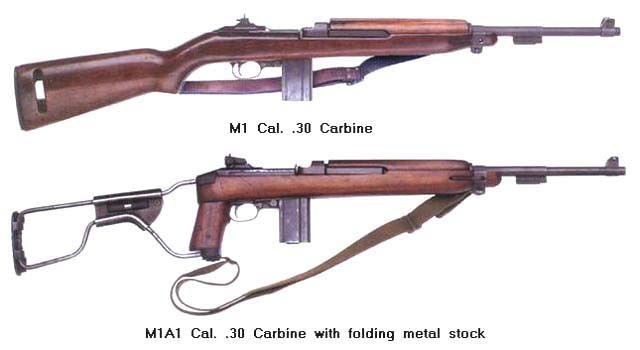
|
Caliber
|
.30 Carbine M1
|
|
Operation
|
Gas, semi-automatic (M1); selective fire (M2)
|
|
Length
|
35.6 inches
|
|
Barrel
|
18 inches
|
|
Weight
|
5.5 pounds
|
|
Magazines
|
15- or 30-round staggered row, detachable box
|
|
Cyclic Rate
|
750-770 rounds per minute (M2 only)
|
|
Placed in the same category as a "pea-shooter", the U.S. Marine Corps had a very poor opinion of the .30 caliber carbine as a firearm. The few (about a dozen) carbines that the squadron had in its armory probably accounted for 80% of the Marine Corps' total inventory of that weapon. Nevertheless, we had them. The only person in the squadron to use one was, again, S/Sgt. Warren F. Atwood, who had a nickel-plated M-2 carbine sans shoulderstock, so that it looked like a machine pistol. The M-2 is capable of semi- or automatic-fire, whereas the other two are strictly semi-automatic. It fires the .30 caliber carbine round, which is not to be confused with the .30 caliber (.30-06 Springfield) round fired by the M-1 Rifle.
|
U.S. Pistol, Caliber .45, Model 1911A1
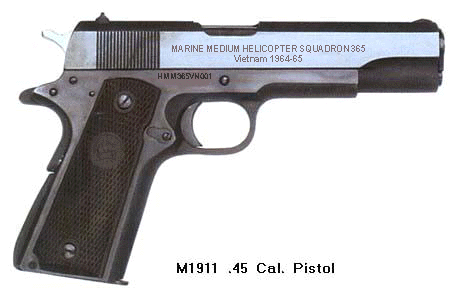
|
Caliber
|
.45 ACP (Automatic Colt Pistol)
|
|
Operation
|
Recoil, semi-automatic
|
|
Length
|
8.62 inches
|
|
Barrel
|
5 inches
|
|
Weight
|
2.43 pounds
|
|
Magazine
|
7-round, inline, detachable box
|
|
This pistol was the regulation Table of Equipment sidearm authorized for non-flight status officers, staff noncommissioned officers, and personnel on special duty (e.g., duty NCO, paymaster, brig chaser). The pistol/cartridge combination has a great reputation in achieving one-round incapacitating shots, but it also had a bad reputation among tyros for being a hard kicker and difficult to shoot accurately. This is not true, as I was later to discover that the "forty-five" can be accurately employed single-shot or rapid. Today, this handgun remains my primary choice for use as a defensive weapon. 1stSgt Howard Force always packed one during Combat Recovery Team missions. It fires the .45 ACP round from a 7-round magazine, weighs 2.43 lbs., and is 8.62 inches long with a 5-inch barrel.
|
|
Commercially known as the Smith & Wesson, Model 10, this double-action revolver chambers the .38 Special cartridge in a six-shot cylinder. It weighs 32 ozs. and is 11.12 inces long with a 6-inch barrel. This revolver was the regulation issue to U.S. Navy and Marine Corps flight-status personnel from 1942 to the Vietnam War. The Marine Corps, always known for its frugality, probably issued the earlier-made World War II Victory Model revolver to the squadron. The ammunition was strictly the copper-jacketed round-nose hardball .38 Special cartridge. Originally issued with a leather shoulder holster, most of the pilots and crewmembers who carried this revolver opted to holster it from the the hip, slung low cowboy-style. As Willard Reeves tells it, the hip-holstered revolver was more accessible for the crewchief, especially when they were transporting and guarding Viet Cong prisoners aboard their aircraft. They could aim and fire their M-60 machinegun with one hand and hold their revolver with the other to keep the captive VC at bay.
|
U.S. Revolver, Caliber .38 Special, Military and Police
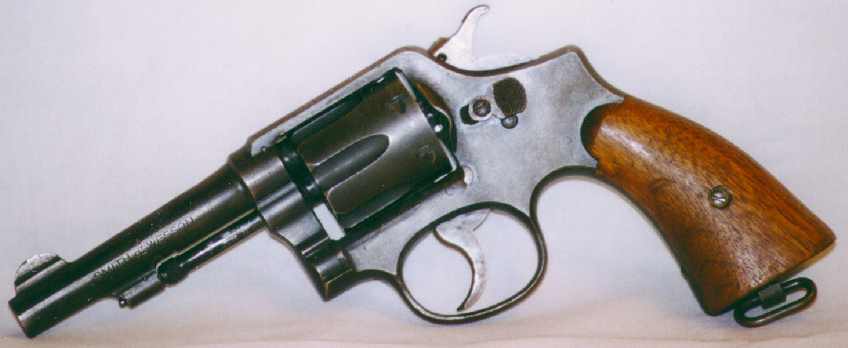
|
U.S. Rifle, Caliber 7.62 NATO, M-14

|
Caliber
|
7.62 x 51 mm NATO (.308 Winchester)
|
|
Operation
|
Gas operated, selective fire
|
|
Length
|
44.14 inches
|
|
Barrel
|
22 inches
|
|
Weight
|
8.7 pounds
|
|
Magazine
|
20-round, staggered box, detachable
|
|
Cyclic Rate
|
750 rounds per minute
|
|
The M-14 was the regulation Table of Equipment weapon issued to all enlisted Marines regardless of military occupational specialty. Although it has full-automatic fire capability, the removable selective switch was not normally issued, keeping the M-14 in its semi-automatic firing mode. Firing this weapon on full-automatic made it difficult to direct accurate fire at a target, or even the general area of the target. The light weight in relation to the recoil of this rifle, in addition to the stock design configuration, made the M-14 a poor replacement for the beloved Browning Automatic Rifle. Still the M-14 proved to be reliable and lethal in combat in the hands of Marines.
|
Note about Marine Corps Marksmanship Training: All Marines are required to qualify with their rifle, regardless of rank or occupational specialty. Fifty rounds are fired - at 200 yards slow fire, 10 rounds offhand (standing); 200 yards 10 rounds sustained fire from the sitting position; 300 yards slow fire, 5 rounds from the sitting and 5 rounds from the kneeling positions; 300 yards sustained firing from the prone position; and 500 yards 10 rounds from the prone position. Each shot was scored from 5 to zero with the perfect score being 250. Minimum qualification score was 190 to achieve a marksman badge. A score of 210 gained the shooter the sharpshooter badge, and a score of 225 was needed to qualify as rifle expert. To my knowledge no one has ever fired a perfect 250 in qualification.
Note about Marine Corps Weapons Training prior to the Vietnam War: Besides the mandatory rifle qualification, each Marine was also given training on the M1911A1 .45 caliber pistol, Browning Automatic Rifle (BAR), 3.5 inch rocket launcher, flamethrower, machinegun (M1919A4 or M-60), 75 mm recoilless rifle, rifle grenades, handgrenades, explosives, and bayonet.
Personal Weapons: Personal sidearms were carried, especially by flight crewmembers. Those that chose to carry their own handgun usually carried Smith and Wesson .357 magnum double action revolver. L/Cpl Basil Atad chose to carry a S&W .45 Colt. L/Cpl John Williams carried a Ruger Single-Six Revolver with a .22 Magnum cylinder. His reasoning for choosing that weapon caliber is that he felt it would be the best survival round, i.e., for hunting small game, but also potent enough for close in self-defense against human targets. The most questionable sidearm I ever saw carried by a Marine during our tour of duty in Vietnam was a single-shot, muzzle-loading .45 caliber blackpowder Philadelphia Derringer, holstered on the hip of a grunt from the 1st Light Anti-aircraft Missile Battalion (LAAMS) assigned to defend DaNang against hostile aircraft.
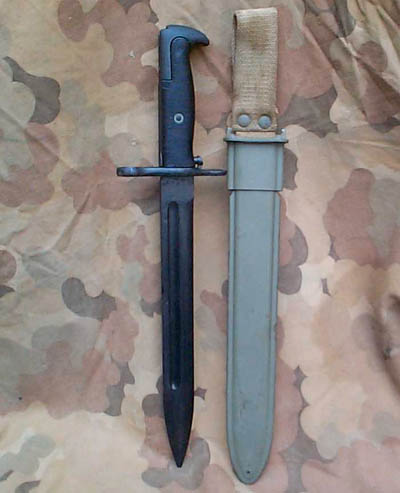 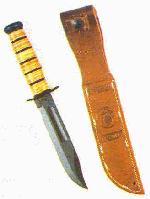  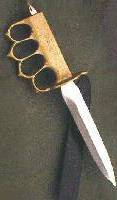
Blades: all personnel who were authorized the issue M-14 Rifle were also issued the regulation bayonet. Flight status personnel usually carried their personal blade choice, either the legendary U.S. Marine Corps K-bar or the U.S. Air Force Survival Sheath Knife, which I carried. Gunner Ball carried a WWI-era brass-knuckled Trench Knife.
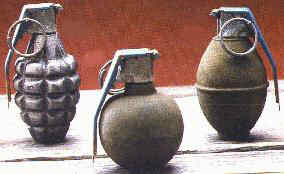 Grenades: all flight status personnel carried smoke grenades in varied colors for marking and signalling. On Combat Recovery Team missions I usually carried four M-26A1 fragmentation grenades and a smoke grenade. Some other CRT members carried Mk3A2 concussion grenades as well. AN-M14 thermite grenades were carried in each aircraft in the event the helicopter or any equipment had to be destroyed. White phosphorus (willy peter) WP M15 grenades were used both for destruction of equipment and as an anti-personnel grenade.
Grenades: all flight status personnel carried smoke grenades in varied colors for marking and signalling. On Combat Recovery Team missions I usually carried four M-26A1 fragmentation grenades and a smoke grenade. Some other CRT members carried Mk3A2 concussion grenades as well. AN-M14 thermite grenades were carried in each aircraft in the event the helicopter or any equipment had to be destroyed. White phosphorus (willy peter) WP M15 grenades were used both for destruction of equipment and as an anti-personnel grenade.
Explosives and Demolitions: were used exclusively by the Combat Recovery Team for the clearing of trees and other obstacles from helicopter landing zones and recovery sites, and for destruction of equipment and structures. The explosives and associated material available to the CRT were Composition C-4 plastic explosives, TNT, detonation cord, blasting caps (both electrical and non-electrical), time-delay fuses and demolition matches. When rappelling from a helicopter the CRT member carrying the blasting caps would tape the wooden protective box that contained the caps onto his steel helmet.
|





